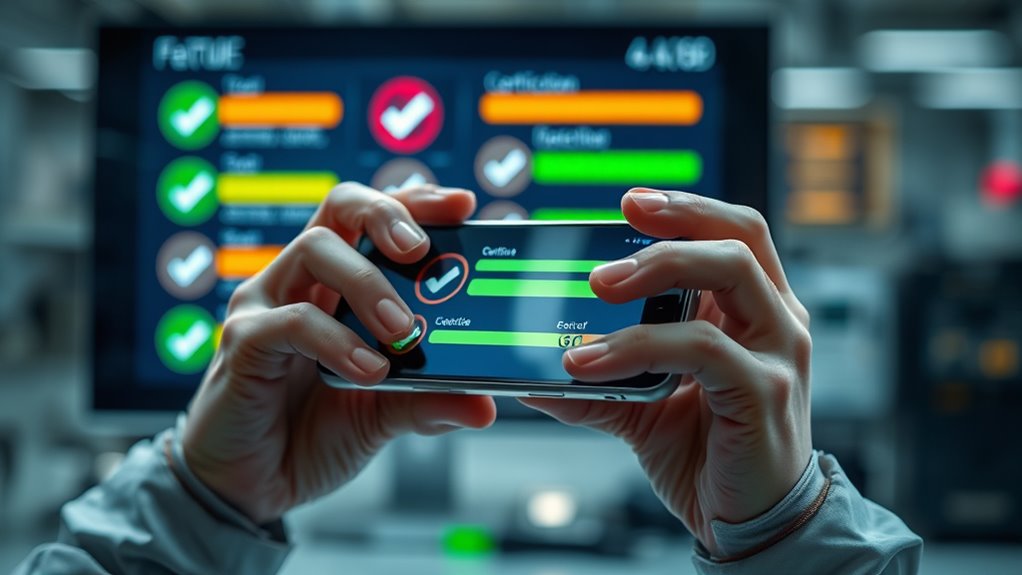To pass tap-to-phone certification on your first try, focus on safeguarding your device with robust encryption, secure elements, and safe communication channels. Streamline your onboarding process to balance security with user-friendliness, verifying identities thoroughly. Familiarize yourself with industry standards like PCI SSC and EMVCo, conduct thorough testing, and prepare detailed documentation. Staying proactive with updates and clear communication ensures all requirements are met. Keep exploring further, and you’ll uncover essential strategies for success.
Key Takeaways
- Review all certification guidelines thoroughly and understand specific security and technical requirements in advance.
- Conduct internal security audits, vulnerability testing, and simulate attack scenarios to ensure robust defenses.
- Prepare comprehensive documentation of security measures, onboarding processes, and compliance steps for review.
- Engage early with certification bodies for clarifications and updates, and incorporate their feedback promptly.
- Perform extensive testing under varied conditions, verifying hardware/software performance and adherence to standards before submission.

Tap-to-phone certification is transforming mobile payments by ensuring that devices meet strict security and performance standards. When you’re aiming to pass the lab on your first try, understanding the core requirements is essential. One of the key areas you need to focus on is mobile security. Certification bodies scrutinize how well your device protects user data during transactions. This means implementing robust encryption protocols, secure element integration, and safe communication channels. Your device must demonstrate resilience against common security threats, such as data interception or unauthorized access. Ensuring high mobile security isn’t just about meeting the baseline standards; it involves proactive testing and validation of all security layers to prevent vulnerabilities that could compromise user trust.
Another critical aspect is user onboarding. The certification process emphasizes seamless and secure user onboarding experiences. You need to design onboarding flows that are straightforward yet safeguard user information effectively. This involves guiding users through device setup, ensuring they understand security features, and verifying their identity where necessary. The onboarding process should minimize friction while maintaining strict security checks, like device authentication and data validation. Proper onboarding not only helps users feel confident in using tap-to-phone payments but also aligns with certification standards that demand clear communication of security measures and user data privacy policies. Incorporating security best practices early in the development process can significantly reduce the risk of certification delays. Additionally, keeping up with the latest updates in AI security can help identify potential vulnerabilities in your security infrastructure before certification. A thorough understanding of security standards and regular training for your development team can further enhance your readiness.
To increase your chances of passing the lab on the first attempt, you should thoroughly review the certification guidelines before beginning testing. Familiarize yourself with specific security requirements, such as compliance with PCI SSC standards or EMVCo specifications, which often serve as benchmarks. Conduct internal audits and security assessments proactively—simulate potential attack vectors and verify that your device responds appropriately. Also, ensure your device’s hardware and software are fully tested for performance under various conditions to prevent unexpected failures during certification. Preparing detailed documentation of your security measures and user onboarding procedures is equally essential, as it demonstrates your commitment to compliance and helps streamline the review process. Additionally, engaging in regional resources can provide tailored guidance and insights to address local standards and expectations more effectively. Staying informed about certification updates and industry trends can further help you anticipate evolving requirements.
Finally, keep communication open with the certification body. If you encounter issues, seek clarifications early and be ready to adjust your implementation accordingly. Staying updated on evolving standards and best practices will also help you maintain compliance. Remember, passing the certification on your first try hinges on meticulous preparation, understanding the importance of mobile security, and crafting an intuitive user onboarding process. By focusing on these critical areas and thoroughly testing your device, you position yourself for a smoother certification journey and a faster route to launching secure, reliable tap-to-phone payment solutions.
Frequently Asked Questions
What Are Common Reasons for Certification Rejection?
You might face certification rejection if your device isn’t fully compatible or if there’s a mismatch in device specifications. Issues often stem from poor testing environment conditions, such as inadequate network setup or unstable connections. Make sure your device meets all compatibility requirements and that testing conditions mimic real-world usage. Addressing these areas guarantees smoother certification, reducing the chances of rejection and increasing your likelihood of passing on the first try.
How Long Does the Certification Process Typically Take?
Imagine you’re anxious to get certified quickly, and it usually takes around four to six weeks. During this time, your team guarantees payment security and device compatibility. For example, a retailer might face delays if their devices aren’t fully compatible. The process involves testing, review, and adjustments. Staying proactive and prepared speeds things up, but deadlines can vary based on certification complexity and project readiness.
Are There Specific Device Requirements for Certification?
You need to guarantee your device meets specific requirements for certification. Focus on device compatibility and hardware specifications, as these are vital for passing the lab. Check that your hardware supports the necessary NFC or contactless payment capabilities and matches the required standards. By verifying these factors beforehand, you increase your chances of passing the certification process on the first try, avoiding delays and additional testing.
Can Certification Be Expedited if Needed Urgently?
If you need urgent certification, you might wonder about expedited approval. While standard processes ensure thorough testing, some certifiers offer priority review for urgent certification requests. To increase your chances, contact the certifying body directly, explain your situation, and provide all necessary documentation promptly. Keep in mind, expedited approval isn’t guaranteed, but demonstrating urgency can help accelerate the process. Always check with the certifier beforehand for specific options.
What Resources Are Available for Troubleshooting Certification Issues?
Imagine you’re a traveler lost in a dense forest, searching for the right path. Your troubleshooting tools are like a compass and map, guiding you through certification issues. Support forums serve as a helpful community of fellow explorers sharing advice and solutions. Use these resources to navigate challenges efficiently, troubleshoot problems, and stay on course toward certification success on your first attempt.
Conclusion
Getting your tap-to-phone certification on the first try is achievable if you follow the right steps. Remember, over 70% of companies who prepare thoroughly pass their lab exams on the first attempt. Stay focused, review all requirements, and practice consistently. With dedication and attention to detail, you’ll increase your chances of success and get certified faster. Keep pushing forward—your certification is within reach, and the benefits will be worth every effort.










